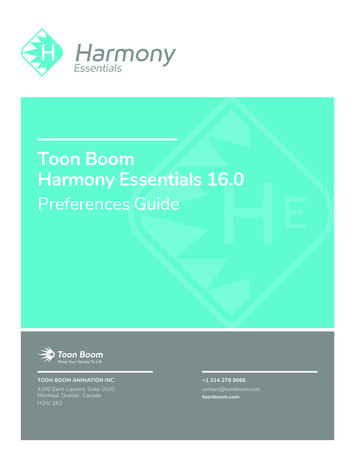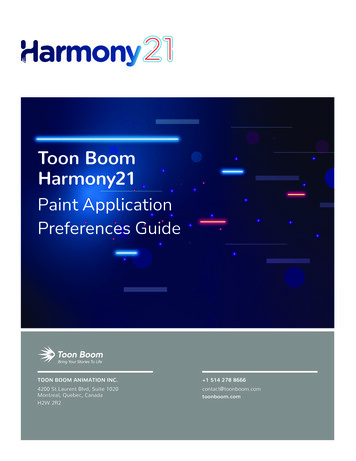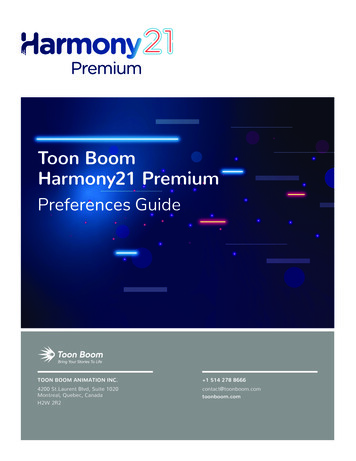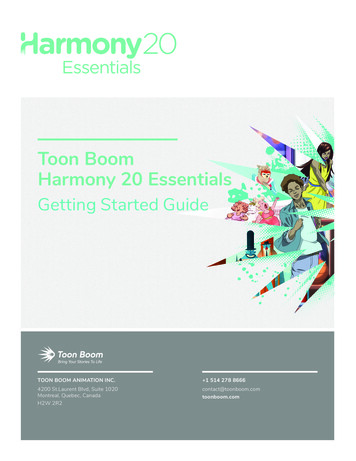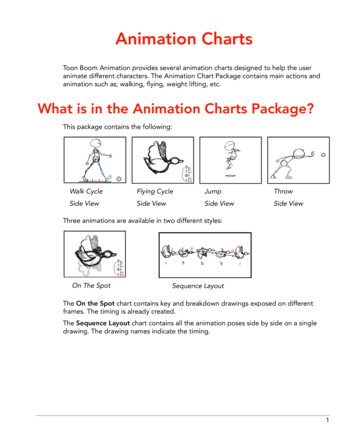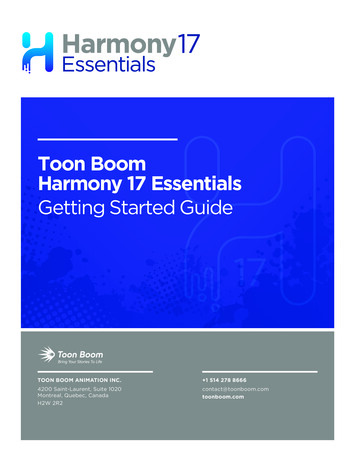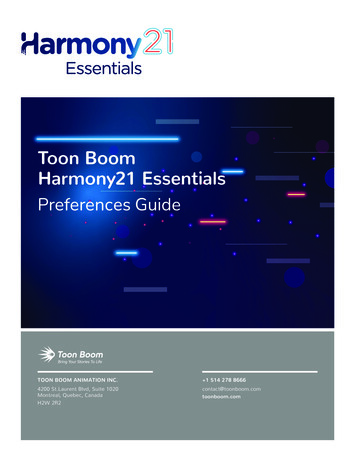
Transcription
Toon BoomHarmony21 EssentialsPreferences GuideTOON BOOM ANIMATION INC. 1 514 278 86664200 St.Laurent Blvd, Suite 1020Montreal, Quebec, CanadaH2W 2R2contact@toonboom.comtoonboom.com
Harmony 21 Essentials Preferences GuideLegal NoticesToon Boom Animation Inc.4200 Saint-Laurent, Suite 1020Montreal, Quebec, CanadaH2W 2R2Tel: 1 514 278 8666Fax: 1 514 278 2666toonboom.comDisclaimerThe content of this document is the property of Toon Boom Animation Inc. and is copyrighted. Anyreproduction in whole or in part is strictly prohibited.The content of this document is covered by a specific limited warranty and exclusions and limit of liabilityunder the applicable License Agreement as supplemented by the special terms and conditions forAdobe Flash File Format (SWF). For details, refer to the License Agreement and to those special terms andconditions.TrademarksToon Boom is a registered trademark. Harmony and the Toon Boom logo are trademarks of Toon BoomAnimation Inc. All other trademarks of the property of their respective owners.Publication Date07-03-2021Copyright 2021 Toon Boom Animation Inc., a Corus Entertainment Inc. company. All rights reserved.1
Table of ContentsTable of ContentsTable of Contents2About Harmony Preferences4Accessing the Preferences Dialog6Switching Between Preference Sets8Exporting Preferences10Importing Preferences12Resetting Preferences14Preferences File Location16Preferences Dialog Reference18General Preferences19Camera Preferences24Exposure Sheet Preferences25Drawing Preferences26OpenGL Preferences28Advanced Preferences302
Harmony 21 Essentials Preferences Guide3
About Harmony PreferencesAbout Harmony PreferencesThe Preferences dialog box allows you to adjust preferences to suit your workflow and your production's needs.4
Harmony 21 Essentials Preferences Guide5
Accessing the Preferences DialogAccessing the Preferences DialogYou can access the Preferences dialog from the Edit menu on Windows, or from the Harmony Essentials menuon macOS.How to open the Preferences dialog box1. Do one of the following:llWindows:lIn the top menu, select Edit Preferences.lPress Ctrl U.macOS:lIn the top menu, select Harmony Essentials Preferences.lPress U.6
Harmony 21 Essentials Preferences Guide7
Switching Between Preference SetsSwitching Between Preference SetsHarmony comes preloaded with five different preference presets (referred to as preference sets), each tailoredfor a different kind of task. By default, the Basic preference set is used. You can choose which preference set touse in Preferences dialog.A large part of the default settings in the different preference sets are the same. The following table describeswhich option is different depending in each preference set, and how:Preference SetTab /LocationPreferenceGeneralPencil lessAnimationRiggingFocus onMouse EnterOffOnOnOnOnDefaultSeparatePosition fOnAuto CloseGapOnOnOnOnOffNOTESlWhen you customize a preference manually, it is not saved to the current preference set. It issaved as an override for all preference sets.lSwitching between preference sets only affects preferences that you have not manuallycustomized yourself. This means, for example, that if you manually enable the Focus on MouseEnter preference, this preference will no longer be affected when you switch to a differentpreference set.lTo make all your preferences affected by the preference set you select again, you must resetyour preferences—see Resetting Preferences on page 14.8
Harmony 21 Essentials Preferences GuideHow to switch between preference presets1. Do one of the following to open the Preferences dialog:llWindows:lIn the top menu, select Edit Preferences.lPress Ctrl U.macOS:lIn the top menu, select Harmony Essentials Preferences.lPress U.2. In the top-left corner of the Preferences dialog, open the Preference Set drop-down and select thepreset you want to use.Preferences will be updated according to the table above, except for those that you manually set.3. Click on OK.9
Exporting PreferencesExporting PreferencesYou can export your current preferences to an XML file. You can reimport this file later to restore yourpreferences, or share it with project collaborators so that you all use the same preferences.NOTEWhen you export your preferences, only the preferences for the currently selected preference setare exported.How to export your preferences configuration1. Do one of the following to open the Keyboard Shortcuts dialog:llWindows:lIn the top menu, select Edit Preferences.lPress Ctrl U.macOS:lIn the top menu, select Harmony Essentials Preferences.lPress U.2. Near the top of the dialog, right of the Preference Set: drop-down, click on the Save. button.A save dialog appears.3. Browse to the location where you want to save your preference file.4. Type in the desired name for your preference file.5. Click on Save.Your current preference settings have been exported as an XML file, in the selected location withthe file name you gave it.10
Harmony 21 Essentials Preferences Guide11
Importing PreferencesImporting PreferencesYou can import a preference file exported from Harmony.NOTESlTo export preferences into a file, see Exporting Preferences on page 10.lWhen you import a preference file, it will override all your preferences for the currentlyselected preference set.How to import a keyboard shortcut configuration file1. Do one of the following to open the Keyboard Shortcuts dialog:llWindows:lIn the top menu, select Edit Preferences.lPress Ctrl U.macOS:lIn the top menu, select Harmony Essentials Preferences.lPress U.2. At the right of the Preference Set: drop-down, click on the Load. button.An open dialog appears.3. Browse to the directory where your preference file is located.4. Select the preference file you want to import.5. Click on Open.The settings in the selected preference file are loaded into the Preferences dialog, overwriting yourcurrent preferences.12
Harmony 21 Essentials Preferences Guide13
Resetting PreferencesResetting PreferencesYou can reset the preferences in Harmony to their default settings.IMPORTANTThis will permanently undo all the changes you made to your Harmony preferences.How to reset your keyboard shortcuts configuration1. Do one of the following to open the Keyboard Shortcuts dialog:lWindows: In the top menu, select Edit Keyboard Shortcuts.lmacOS: In the top menu, select Harmony Essentials Keyboard Shortcuts.2. In the bottom-left corner of the Preferences dialog, click on Restore All Defaults.A confirmation prompt appears.3. If you are sure you want to restore the default preferences for Harmony, click on Yes.All the preferences in the Preferences dialog are now set to their default setting.14
Harmony 21 Essentials Preferences Guide15
Preferences File LocationPreferences File LocationT-HFND-002-002After the first time you have launched Harmony, your preferences, along with numerous other options andswitches in the user interface, are stored in a hidden directory on your computer.Depending on your operating system, you can find your preference files in the following location:lWindows: C:\Users\[username]\AppData\Roaming\Toon Boom Animation\Toon Boom HarmonyEssentials\full-2000-prefNOTEOn Windows, the AppData folder is hidden. To display it in Explorer, in the top menu, openthe View pane and check the Hidden Items checkbox.lmacOS: /Users/[username]/Library/Preferences/Toon Boom Animation/Toon Boom HarmonyEssentials/full-2000-prefNOTEOn macOS, the Library folder is hidden. To display it in Finder, hold down the Alt key.16
Harmony 21 Essentials Preferences Guide17
Preferences Dialog ReferencePreferences Dialog ReferenceThe following section contains a an article for each tab in the Preferences dialog. Each article contains a list ofall the preferences in its tab, as well as a description of the preference. Refer to this section if you want to knowmore about what a specific preference does or if you want to get familiarized with all of the preferences inHarmony.General Preferences19Camera Preferences24Exposure Sheet Preferences25Drawing Preferences26OpenGL Preferences28Advanced Preferences3018
Harmony 21 Essentials Preferences GuideGeneral PreferencesTo customize your interface, you will use some of the preferences located in the General tab as well as theCamera tab.ParameterDescriptionIn Harmony Server, you can decide which kinds of assets are saved whenyou use the Save command. This can be useful if you need specific users toonly be able to make changes to certain aspects of the scene they'reworking on, or if you want to prevent yourself from accidentally makingundesired changes to important assets. Unchecking any of the followingoptions will prevent you from saving their corresponding type of assets:lSavelllSave Scene: Save changes to the list of layers, elements, animation,timing, layout, effects, scene properties, etc.Save Palette Lists: Save changes to the list of palettes associatedto the scene or to individual elements.Save Palettes: Save changes to the colours and textures containedin palettes.Save Drawings: Save changes to existing drawings as well asnewly created drawings.19
Preferences Dialog ReferenceTIPIf you want to save changes made to a type of asset that for whichsaving was disabled, you can do so by selecting File AdvancedSave from the top menu. In the Advanced Save dialog, assets forwhich saving is disabled will be unchecked, so you must manuallycheck the assets you want to save.IMPORTANTWhen you close a scene, Harmony will not ask for confirmation todiscard changes made to assets for which saving is disabled.Auto-Save:lllInterval (minutes): This is the frequency at which the auto-savetakes place.Inactivity Interval (seconds): When Auto-save is about to takeplace, it verifies if you are drawing or doing anything in theapplication. If so, Auto-save waits this number of seconds beforeattempting another save.Ask Before Saving: Before performing an auto-save, the system willprompt you with a message to confirm if you want to save or not.You can choose to turn off this option.lEnabled: This enables the Auto-save feature. If you do not want thesystem to automatically save your work, deselect this option. Theauto-save is off by default.Automatically Save Workspace: Changes to your workspace, such ashow views and toolbars are laid out, are automatically saved, making sureyour workspace remains the same after you close and re-launch Harmonyor if you switch between different workspaces. If this option is disabled,you must manually save changes to your workspace by selecting Windows Workspace Save Workspace from the top menu.OptionsSupport Gestures: Enables manipulating views such as the Camera andDrawing views using the following gestures:lTo pan the view, drag your two fingers in any direction, keepingboth fingers at the same distance from each other.20
Harmony 21 Essentials Preferences GuidelTo zoom in, drag your two fingers away from each other.lTo zoom out, drag your two fingers closer to each other.lTo rotate, drag your two fingers in a curve so that they revolve in thesame direction.21
Preferences Dialog ReferenceInvert Scroll Direction: When panning a view by dragging it with yourfingers in one direction, this makes the view pan in the opposite direction.Touch Sensitivity: Control touch sensitivity. On macOS, higher numbersgive a slower response to pans. On Windows, higher numbers favourscale/rotates over pans.Auto Render: Controls whether the Camera view's Auto Render option isenabled or disabled when launching Harmony. When Auto Render isdisabled, if any change is made to the scene while the Camera view is inRender Preview mode, it will switch to OpenGL Preview mode. Whenenabled, it will merely refresh the render preview.Focus on Mouse Enter: In Harmony, some keyboard shortcuts, menus ortoolbar buttons are intended for specific views in your workspace. To usekeyboard shortcuts or other functionalities on a specific view, this viewmust be focused on. For example, the Centre on Selection shortcut will findthe selected element in the Timeline or Camera view, depending on whichone is focused on. Harmony draws a red rectangle around the currentlyfocused on view.By default, to set the focus on a view, you must click on its tab or onanything inside the view itself. The Focus on Mouse Enter preference willmake Harmony automatically focus on the view the mouse cursor is over,making it switch the focus on a view and use keyboard shortcuts on it.22
Harmony 21 Essentials Preferences GuideNOTESome items in the top menu also have functionalities that arespecific to the focused on view, but moving the mouse cursor to thetop menu might leave the wrong view focused on. To circumventthis problem, it might be necessary to become familiar withkeyboard shortcuts, contextual (right-click) menus and the viewmenus available via the menubutton at the top-left corner ofsome views.Use Dark StyleSheet (Requires Relaunch): Application loads a dark skinfor the User Interface.Language (Requires Relaunch): The language in which to display the userinterface.LanguageBy default, this is set to Autodetect, which means that Harmony willlaunch in the language of your operating system, if it is one of thesupported languages, and will otherwise launch in English.Stop-Motion Keyframes: New keyframes are created as stop-motionkeyframes.SettingsDefault Separate Position for Pegs: New pegs are created with separateposition functions.Default Separate Scale for Pegs: New pegs are created with separatescale functions.TimelineAdd Keyframe at Beginning and End: Add keyframes at beginning andend: Select this option to copy and paste a set of frames that includes aninterpolated sequence between two keyframes, but only extracts a partialsection. Under normal circumstances, cutting and pasting a functionwithout either the start or end keyframe would render the function null.This option caps the partial function with a new keyframe when youperform the paste.Extend Exposure of Previous Drawing: When drawing on a blank frame, anew drawing is created and the timing is extended from the previousexposed drawing.23
Preferences Dialog ReferenceCamera PreferencesParameterDescriptionSettingsSet Keyframe At Frame One With First Application of the Transform Tool:When this option is selected, wherever you set a keyframe on a layer, a keyframeis added on your frame 1. If this options is deselected, a keyframe is only addedto the current frame. If later on, you add a keyframe on your frame 1, it may modifythe first keyframe you added.Small Bitmap Resolution: The size, in pixels, of the smaller bitmap version ofyour image. When you import a bitmap image into a scene, a smaller version of itis created in order to accelerate the compositing and playback processes.Show Control Points On Selected Layers: By default, when you select anelement with the Transform tool, the motion path related to the object isdisplayed.Control PointsControl Point Tension: The default Tension value for new keyframes and controlpoints.Control Point Continuity: The default Continuity value for new keyframes andcontrol points.Control Point Bias: The default Bias value for new keyframes and control points.ColoursBackground Colour: Lets you change the background colour of the Camera viewin OpenGL View mode.24
Harmony 21 Essentials Preferences GuideExposure Sheet PreferencesParameterDescriptionThese preferences are used to display or hide certain layer types in the Xsheetview.Show Drawing Columns: Displays the Drawing layers in the Xsheet view.FilteringShow Sound Columns: Displays the Sound columns in the Xsheet view.Show 3D Path Columns: Displays the 3D Path columns in the Xsheet view.Show Function Columns: Displays the Function columns layers in the Xsheetview.OptionsDefault Add Columns: The default position where the new column will beadded.Default Column Width: The default width value for the new column beingcreated.You can set the minimum and maximum zoom levels to view the Xsheet,depending on the number of columns and rows in the project. Once you set alevel, close and reopen the Xsheet so the new values take effect.Minimum Zoom Level: Lets you set the lowest level of zoom. Choose a valuebetween 1 and 6.Zoom LevelsMaximum Zoom Level: Lets you set the highest level of zoom. Choose a valuebetween 14 and 20.NOTEYou can set a keyboard shortcut to view the entire Xsheet.25
Preferences Dialog ReferenceDrawing PreferencesParameterDescriptionOnion Skin Render Style: Original Colours: Drawings displayed in the Onion Skin are renderedusing their real colours. Coloured:Drawings displayed in the Onion Skin are displayed in solid redif they are before the current frame, or in solid green if they are after thecurrent frame. Light TableColoured Outlines: Drawings displayed in the Onion Skin are displayedin red outlines if they are before the current frame and in green outlines ifthey are after the current frame.Light Table: Enable Shade: When enabled, the drawings appearing on the LightTable are displayed in washed out colours in the Drawing view. When thisoption is disabled, the drawings appearing in the Light Table are displayed usingnormal colours. This option is for the Drawing view only.Light Table: Shade in Camera View: When enabled, the drawings appearing onother layers are displayed in washed-out colours in the Camera view. When thisoption is disabled, the drawings appearing on other layers are displayed usingnormal colours. This option is for the Camera view only.Grid On By Default: When opening the Drawing view, the grid displaysautomatically.OptionsBrush Size Cursor: When this option is enabled, the brush tool displays thebrush size as a circle around the cursor.Synchronize Eraser and Brush: When enabled, changing any of the Brush tool'sproperties simultaneously changes the corresponding property for the Eraser toolto the same setting, and vice versa. Likewise, selecting a preset for one tool willapply this preset's properties for the other tool.26
Harmony 21 Essentials Preferences GuideAuto Gap Closing in Pixel Units: Disabling this option will cause your gap to bezoom dependent. Zoom dependent means that the more you zoom in, the smallerthe gap you can close with the Close Gap tools. By enabling this option, youchoose to make the gap display available in pixel units, which is not zoomdependent.Auto Gap Closing on Startup: The values for automatic gap closing whilepainting drawings are: 0 Disabled, 1 Small, 2 Medium, 3 Big.Pencil Lines Opacity (%): Lets you set the default tranparency of your pencillines.ColoursBackground Colour: Lets you change the background colour of the Drawingview.Grid Colour: Lets you change the colour of the grid.Enable Paper Zoom: Enabling this option allows you to set the 100% Zoomlevel onscreen, in order to physically match the measurements of your paperdrawing.ZoomNumber of Pixels per Inch: Enter the PPI for your monitor. To obtain the PPI ofyour screen, divide the height or width of your monitor's resolution setting by thecorresponding physical height or width of your monitor screen (resolution heightdivided by physical height, or resolution width divided by physical width) ininches.Quick Close Up Zoom Factor: Sets the zoom level for the Quick Close up Zoomkeyboard shortcut.Maximum Zoom Factor: Sets the maximum zoom level for the paper zoom.27
Preferences Dialog ReferenceOpenGL PreferencesParameterDescriptionConservative Texture Management: Turns on and off conservative memorymanagement for bitmap texture files. Performance will improve when this isenabled. If disabled, you will have a better on-screen rendering of bitmap files atthe expense of slower performance.Smooth Textures: Smooths out the pixels of bitmap images when zooming in;this improves bitmap image quality.Alternate Gradient and Cutter: This is an alternative way to disable write in theOpenGL Backbuffer, required for some video cards (i.e. GeForce FX5200). Do notenable this option unless you are experiencing problems with gradients andcutters in OpenGL.SettingsSupport Triple Buffer: Enable this option for a better compatibility withWindows Vista if your video card driver does not allow to disable the triplebuffering option. Not enabling this option may result in a dashing line whendrawing a brush stroke.Support Desktop Effects: Enable this option for better compatibility withWindows 7, Windows Vista and Mac OS X desktop effects. This will preventgraphic compositing problems from happening when the full-scene anti-aliasingoption is enabled.Maximum Texture Size: The size that the bitmap file will be reduced to whenusing the Conservative Texture Management.Texture Memory: The amount of temporary memory used to store bitmap texturefiles.Vector Drawing Maximum Texture Size: This is the size that the .tvg file will bereduced to for better performance when in OpenGL render mode.28
Harmony 21 Essentials Preferences GuideThe following options allow you to configure the way drawings are previewed inHarmony.Enable (Requires Relaunch) : By default, drawings displayed in Harmony, suchas in the Camera or Drawing view, have no antialiasing and display hard pixels atthe edge of strokes and lines. If this preference is enabled, antialiasing will bedone through the graphic card to enhance the quality of drawings and make apreview that resemble the final render more closely. This may impact applicationperformance negatively.Number of samples: The amount of times the OpenGL preview is scaled upbefore processing it for antialiasing. The higher this value is, the better theantialiasing quality will be but the heavier it will be on the machine's resources.Full Scene AntialiasingNOTESlllIt may be necessary to restart the application to see the effectsafter changing either of these settings.These settings may be overriden by the 3D antialiasing settingsof the driver for your graphics card. If changing these settingsand restarting the application seems to have no effect, make sureyour graphics card supports antialiasing, that antialiasing isenabled and that it is configured to let applications control theirantialiasing.These settings only affect the way drawings are previewed inOpenGL. They have no effect on the final rendered image, or onthe way the image looks when setting the Camera view inRender Preview mode.29
Preferences Dialog ReferenceAdvanced PreferencesParameterAdvanced OptionsDescriptionSupport CMYK in PDF/Illustrator Import: Lets you import .pdf and .ai files thatwere created or exported in CMYK mode. The colours of the resulting importedimage may still not look 100% faithful to its CMYK original due to the RGBconversion. It is recommended that you convert these files to RGB images beforeimporting them into Toon Boom Harmony Essentials. Disabling this option willcause all the colours of the imported image to be displayed as red to indicate thatthe file was not converted to RBG before import.PDF/Illustrator Import as Separate Layers: Imports the differentgroups/elements of the .pdf or .ai file as separate layers. For Illustrator files, theimport will use the top level group as separate layer names. Deselect this optionto import pdf or .ai files as a single layer.Tablet SupportUse Qt Wintab Tablet Support (Requires Relaunch): If you are using a tabletother than Wacom, deselect this option (and relaunch) if you are having issueswith offset or pressure sensitivity.UnicodeAllow Unicode Names: Lets you use up to 120 ASCII characters for names ofenvironments, jobs and scenes. This means you can use characters forlanguages, such as Japanese, Chinese, French, Spanish, and others, charactersfor names in your database setup.30
Toon Boom Animation Inc. 4200 Saint-Laurent, Suite 1020 Montreal, Quebec, Canada H2W 2R2 Tel: 1 514 278 8666 Fax: 1 514 278 2666 toonboom.com Disclaimer The content of this document is the property of Toon Boom Animation Inc. and is copyrighted. Any reproduction in whole or in part is strictly prohibited.

